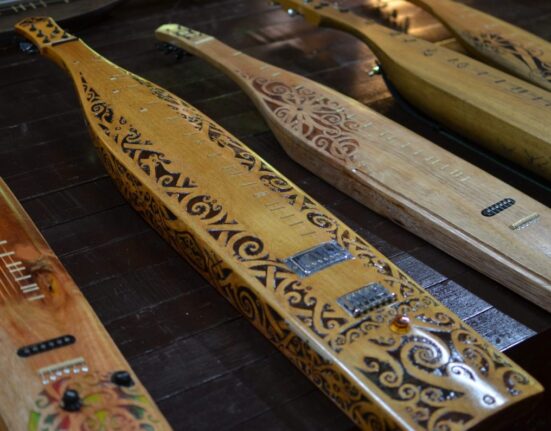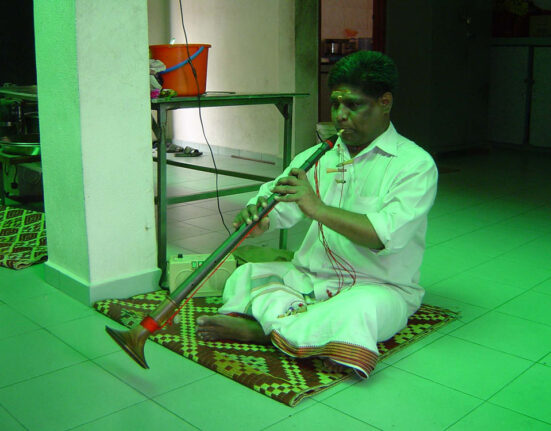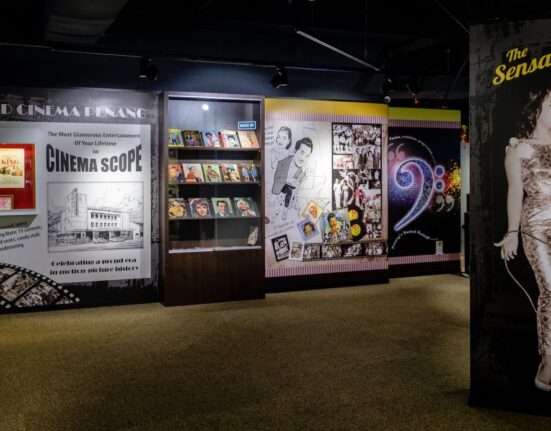Looking up to the changing skies, thinking of the ancestors, it’s the journey of song through the cosmos.
Alena Murang has her roots in Kelabit, the native people from Sarawak, Borneo. As the professional sape’ musician, she is expanding her activities to pass on the songs, music and stories from her ancestors to the next generation. There are stories of the ancestors of Kelabit people who used to live in the skies and on Earth. They had a special relationship with the universe, from the sun to the sky, the trees and all living things. Her latest album “Sky Songs” is a journey of song through the transition of the skies.

The Sape, Alena is holding is the one made by Dines Ngau. The beautiful and delicate paintings using traditional motifs of Sarawak on the instrument is impressive.
— Last year, the film “Small Island Big Song” was screened in Japan and drawn attention of many.
It’s a documentary recording traditional music left on the islands by people who once traveled across the ocean. They also came to my home village in Kelabit Highland to record. When I toured with musicians from other countries as part of the project, the lullaby I heard at the Paiwan musician’s house in southern Taiwan sounded very much like a Kelabit folk song, and I could understand half of the lyrics. Our songs about nature and ancestors are very similar. It was really incredible experience to discover the cultural connection between peoples in Taiwan and Borneo.
— You started to learn playing Sape’ when you were 11 years old.
As the Sape’ used to be an musical instrument for men, me and my cousins were the first female students of the sape’ master, Mathew Ngau. It was a traditional teaching method in which the teacher played and the students imitated. I practiced listening to the cassette that the teacher recorded the performance at home. It was difficult because there were no scores, but now I teach the Sape’ to my students in the same way.
— Over the 20 years , the Sape has been changed in its shape and now it’s played together with other musical instruments of different genres.
While the traditional Sape’ had two or three strings, many of the modern instruments have five or six strings. There is the double-stringed Sape’, too. Also, now we can find Sape’ in different sizes. The Sape’ has been experiencing the changes as the elder Sape’ players are comparatively open to the changes. However, the Sape’ masters always remind us to learn the traditional way of playing and the songs, only then we can proceed to the new styles. For example, the melodic & rhythmic patterns, play the melody while playing the top open string, add decorative notes by plucking the string, these are the elements that makes music unique to Sape’.

New Album “Sky Songs”
— In the new album Sky Songs, there are songs in both Kelabit and Kenyah languages.
Kelabit and Kenyah are geographically and culturally closely related, but the languages are different. And both languages are endangered. Actually, Sape’ was originally from Kenyah culture. The Kelabit songs were sung in a cappella. I combine both of them in my performance.
We are the first generation to be born and raised in the city with roots in indigenous peoples. Like my mother is British, some of my native friends have a parent of non-indigenous people, and English and Malay are their main languages at home, so fewer people speak indigenous languages now. I hope to pass on the Kelabit and Kenyah languages to future generations through traditional songs and stories.
— Please introduce your new music video “Warrior Spirit”.
In the old days, Kelabit men were at times warriors in the jungle. This song is based on the traditional Sape’ piece that depicts the scene on the dawn of battle, the warrior watches the mist rise and meditate to calm down themselves.
For the shooting, we had a makeup artist who has the roots in Lun Bawang, and also the Sarawakian designer who did all the costumes and accessories. While integrating the traditional elements such as beads, which are the characteristics of Kelabit costumes, we created the images with more focus on a unique modern / urban style of our generation. I hope that “Alena Murang” will become a platform and a place where people with different cultural backgrounds can share skills and experiences based on various cultural heritage. The digital distribution of the new album and the music video will be released at the end of May, so please listen to it.
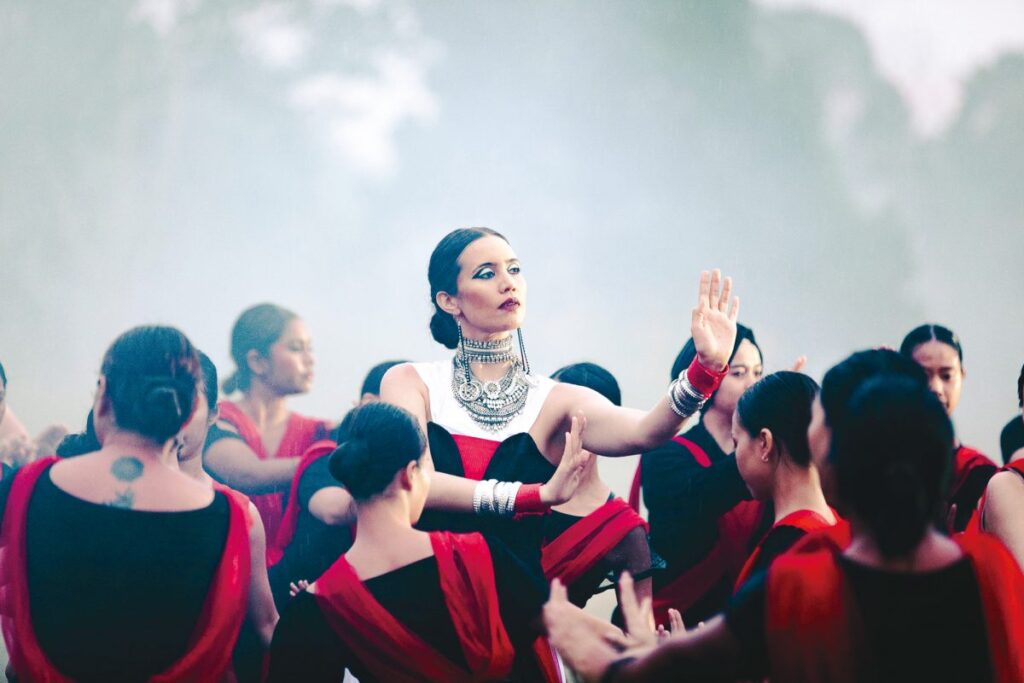
A scene from the new music video “Warrior Spirit”.

NEW ALBUM “Sky Songs”
nspired by the stories of her ancestors that lived in the skies and on Earth, the album is a journey of song through the cosmos; a song for the warriors that watch the mist rise on the morning of battle; a song of watching the clouds to tell of a good time to migrate; a song with lamentations of thunder and the moon. This album「Sky Songs」(2021)and the debut album “Flight”(2016)are available worldwide on the digital platforms including Apple Music, Spotify and others.
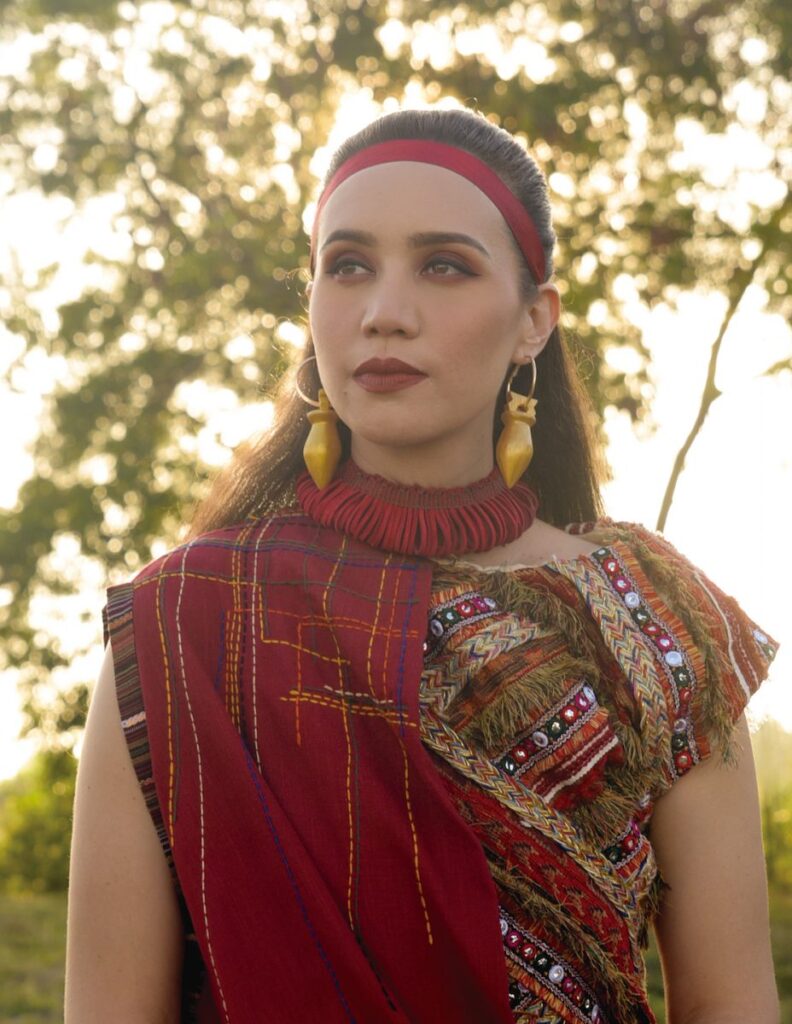
profile:
Sape’ player/ singer-song writer
Born in Kuching, Sarawak, to a Kelabit father and English-Italian mother. She receives songs, music and stories from her Kelabit and Kenyah elders, and presents them in contemporary ways. Alena was part of the revival movement of the sape’, 20 years ago, in the first batch of students from sape’ master & living heritage Mathew Ngau Jau. Her music video “Midang Midang” won the Best Styling award at the Buenos Aires Music Video Festival.
©Clash Donerrin
Web >>> https://www.alenamurang.com/
Facebook >>> @alenamurang
Instagram >>> @alenamurang
“Project Ranih” , a project to harvest the folksongs of Kelabit children
http://www.projectranih.com/
Article by Aki Uehara
Photos courtesy of Alena Murang


